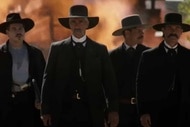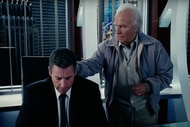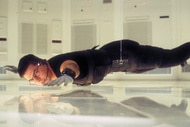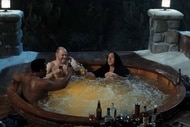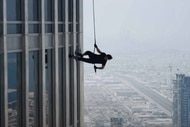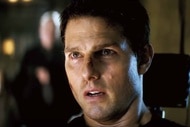Create a free profile to get unlimited access to exclusive videos, sweepstakes, and more!
Why Are Parts of Oppenheimer in Black and White?
There's a method as to why Oppenheimer director Christopher Nolan swaps between color, and black and white.
Director Christopher Nolan's film may be titled Oppenheimer (now streaming exclusively on Peacock), but it's really about the worldview of two men: J. Robert Oppenheimer (Cillian Murphy) and Lewis Strauss (Robert Downey Jr.). Both men had incredible impact on the United States nuclear capabilities, the former in creating it and the latter in determining how the country wielded that power after World War II.
When Nolan decided to adapt Pulitzer Prize-winning book, American Prometheus: The Triumph and Tragedy of J. Robert Oppenheimer by Kai Bird and Martin J. Sherwin, he felt that portraying Oppenheimer's life after the detonation of the bombs in Japan was as critical in understanding the full story of the man dubbed the "father of the atomic bomb." And the person who loomed most large during that period of the scientist's life was Strauss, the chairman of the U.S. Atomic Energy Commission. They represented opposite ends of nuclear ideology - with Oppenheimer as an increasingly ardent opponent and Strauss a firm proponent of its deterrent power.
Why Are Parts of Oppenheimer in Black and White?
Committing to a non-linear narrative that would toggle between two distinct time periods — the development and testing of the bomb vs. Oppenheimer's 1954 closed door security hearings — Nolan decided the best way to portray that would be to use color film stock for Oppenheimer's perspective and black-and-white film stock for Strauss' perspective. Shooting in IMAX 65mm, Nolan says in the press notes for Oppenheimer, that because of the technicalities of the large-format photography and the perspective choices, the rest of the film's aesthetics would otherwise be straightforward.
“No barrier between the world of the film and the audience, no obvious stylization other than the black-and-white sequences," he says of their approach. "But particularly with the color sequences, we wanted very unadorned, simple photography, as natural as possible, revealing lots of textures in the world."
Of course, that mandate was easier said than done because most film today is shot on digital cameras. Oppenheimer cinematographer Hoyte van Hoytema (Nope) shared in the notes that he was unaware of any 65mm black-and-white film stock in existence which required a phone call to Kodak labs.
"We asked: ‘Do you have 65-millimeter black-and-white film?’ And of course, they didn’t, because they never made it before," van Hoytema details. "So, we asked: ‘Can you make it?’” And they were like, ‘Maybe?’ And then we were always nagging them like little kids to do it. Fortunately for us, they really stepped up to the challenge. They supplied us with prototypal film stock — freshly manufactured, with hand-written labels on it — and when we tested it, the first time we saw it, it just blew us away. It was so special and so beautiful.”
With that technical quandary resolved, Nolan was able to commit to shooting Oppenheimer's perspective in color. It's a choice meant to imply the boundless qualities to the scientist's brilliant mind, as expressed with the surreal inserts of quantum theory particles in his imagination and the day-to-day efforts of him building the Manhattan Project in Los Alamos.
For Strauss, the black-and-white footage represents his far more concrete perspective of the world as a conservative who embraced a dogmatic rejection of Communist values. Seeing it as an evil threat to democracy and the United States, Oppenheimer's security clearance meetings — which Strauss orchestrated with his own operatives — reflects his worldview in the interrogation scenes and with how the witnesses are systematically assaulted for any connections or sympathies they might have had with the American Communist Party. The black-and-white is also used in Lewis Strauss' own Congressional Hearings as President Dwight D. Eisenhower's choice to become U.S. Secretary of Commerce, where his methods and dogma come back to haunt him.
How To Stream Oppenheimer?
Oppenheimer is now streaming exclusively on Peacock alongside a slew of behind-the-scenes featurettes.
The NBCUniversal platform currently offers two monthly subscription plans: Premium ($5.99 a month with ads) and Premium Plus ($11.99 a month with no ads and download access for certain titles). If you're a student, you can enjoy the Premium plan for just $1.99 for an entire year!
Looking for some theatrical action in the meantime? The Holdovers, My Big Fat Greek Wedding 3, The Exorcist: Believer, Fast X, Ruby Gillman, Teenage Kraken, Five Nights at Freddy's, and Strays are all streaming on Peacock!
Originally published Jul 21, 2023.

